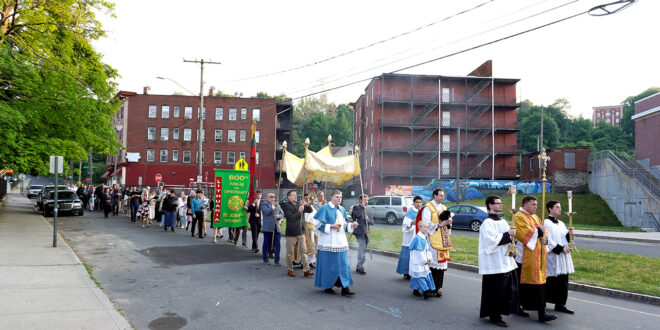The most ambitious internet project documenting Lithuanian American heritage sites is nearing completion. The dynamic duo of Augustinas and Aistė Žemaitis, known as the “Destination Lithuanian America” team, have created an interactive online map and encyclopedia showcasing Lithuanian heritage sites in North America. They have been exploring the U.S. and Canada since 2017, visiting and documenting hundreds of sites, recording their coordinates, and Ć pictures and videos. Along the way, they have interviewed countless Lithuanian Americans, collecting their personal and ancestral stories and documenting the Lithuanian institutions they founded and supported.
Augustinas Žemaitis.
Will this Lithuanian neighborhood come back to life?
This year’s “Destination Lithuanian America 2023” expedition was the most extensive yet. One of its goals was to “plug any holes” leftover from previous expeditions.
It again was an opportunity to visit and explore several distant Lithuanian landmarks and churches. It included sites in Canada, such as Winnipeg and Thunder Bay. Some were situated remotely, almost 1000 km from the nearest other Lithuanian site.
Our objective was to explore all the Lithuanian places that our readers had suggested, ranging from the lakes near Montreal to the monuments in New England, as well as turn-of-the-century Lithuanian churches in Pennsylvania. By the end of this expedition, our site map was expected to be almost complete.
This year’s extensive expedition covered almost as many miles as all our previous expeditions combined. As we traveled, we revisited many places we had visited five or six years ago, reconnected with our local friends, and recorded additional interviews.
For the first time, we could compare how our Lithuanian sites have been faring over the years and what changes have occurred: what has declined and what has been revived?
Return to Waterbury
The expedition began in Waterbury, Connecticut, where Lithuanianness seemed to be resurgent like nowhere else. This Lithuanian site at first seemed secure. Unfortunately, when I was initially penning this article, Waterbury Lithuanians did not yet know that St Joseph Lithuanian Church, which they were so happy to see rediscovered by the young people, was to be closed by the local ordinary as of 2023. I wrote this article, like all my diaries, while I was still on the expedition, so I didn’t know the sad future either. As you read this, please keep in mind how fragile our existence and expectations can be.
What surprised and delighted us in Waterbury
We arrived at the first stop Waterbury, Connecticut, earlier than planned. “You’re only coming on Friday? Come on Thursday evening and you can take part in the procession to the Lithuanian church”, we were told.
The procession involved Lithuanians marching through one of the old town neighborhoods of Waterbury while carrying the Lithuanian tricolor and the pennant of the Knights of Lithuania.
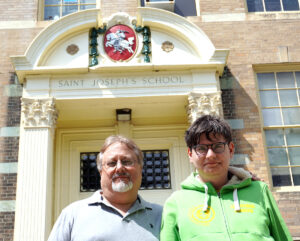
As the procession reached the historic Lithuanian district, I was anxious to see if “everything was in place.” This cluster of Lithuanian structures is among the finest preserved in the United States, so I wanted to make sure everything was in good condition.
To my relief, everything appeared to be in order. The grand Lithuanian school building with its impressive Lithuanian Knight on the facade remained intact. The Vytis had been recently repainted and looked stunning. The Lithuanian church was still accessible to visitors, with its many exquisite Lithuanian stained glass windows.
I noticed Lithuanian tricolors hanging on every light pole in the area! When we last visited here in 2017, this was not the case. I’m used to seeing the decline of old Lithuanian neighborhoods in the US, so it was hard to believe that I was witnessing the revival of a historically Lithuanian neighborhood here.
It’s not as simple as it may seem. There have been some setbacks in the Lithuanian community’s efforts to preserve their cultural heritage. For instance, the parish house and Lithuanian school, both owned by the parish, were sold to the Waterbury municipality. Fortunately, the city repainted the Vytis, the Lithuanian coat of arms, on the building. Local Lithuanians have informed us that the city plans to turn these premises into a cultural center, which could include a Lithuanian museum. This would be an excellent opportunity to showcase Lithuanian exhibits previously “evicted” from the parish by a non-Lithuanian parish priest around 2017. These exhibits are currently lying around the church and in its basement.
One man’s contribution – tricolors on the street pillars
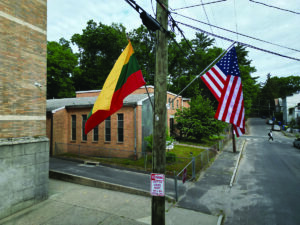
Fresh winds are blowing in Waterbury as new people have joined the ranks of long-time parish activists like Linas Balsys and Petras Verseckas, whom we met six years ago.
One of the “new Waterbury Lithuanians” we interviewed is Erikas Bartkus. He moved to Waterbury from New York and has been working on establishing a Lithuanian museum in the city. This idea has not yet been realized, but Erikas has made significant progress. He purchased one of the old houses in Waterbury’s historic Lithuanian neighborhood to revive the Lithuanian spirit in the area. For the past several years, Erikas has organized a vibrant Lithuanian Midsummer celebration in the backyard of the house, attracting over 100 attendees annually. Additionally, he decided to decorate every pole in the Waterbury Lithuanian neighborhood with a tricolor for Midsummer Day in 2023.
“I missed being Lithuanian”
I was pleasantly surprised to meet a new parishioner, Christian Allyn, an elected alderman and successful businessman from the nearby town of North Canaan. He is 28 years old, only a quarter Lithuanian, and his family moved away from Waterbury long ago. Christian’s life changed when he visited Waterbury’s Lithuanian neighborhood one day and saw its grand buildings and, to his surprise, St. Joseph Church was still open (erroneous information on the internet indicated it had been closed long ago).

“I realized what I was missing in my life – being Lithuanian,” he said, and he is now filling that void. He joined the parish, the Knights of Lithuania, and the Waterbury Lithuanian Club (the same one whose building was burnt down some 20 years ago). He rented an apartment in what he said was “the last apartment block in Waterbury’s Lithuanian area, which Lithuanians have always inhabited.”
He invited us to his apartment, which he is renovating. Both a US flag and a Lithuanian tricolor are there. Christian is also interested in the Lithuanian history of Waterbury. He suggested that we add a site to the www.tikslasamerika.lt map. This is a memorial dedicated to the people who lost their lives in the 1955 flood that took place in Waterbury’s Lithuanian neighborhood. The memorial bears the names of 29 victims, of which 17 are clearly Lithuanian. However, there may be more Lithuanians on this list, as many early immigrants changed their names to sound more “American.” Therefore, this could be the worst Lithuanian-American disaster ever recorded.
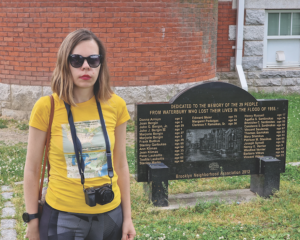
Christian has ambitious plans for the future of the Lithuanian neighborhood. When the city acquired the Lithuanian school, they relocated the statue of St. Joseph nearer to the church. However, the pedestal where the statue once stood remains in place. Christian intends to install a monument to King Mindaugas in that spot.
“Nowadays, a lot of young people are returning to the cities, which means that the district can be revived. However, some issues like a torn sewer cover need to be addressed,” stated Christian Allyn. As a public servant, he added that “when the area is untidy, potential newcomers might think it’s a bad neighbourhood where nobody cares. But in reality, I’ve parked my car here for a year and a half, and nothing bad has happened to it.”
Christian’s observations
If more individuals like Christian existed, the old Lithuanian clubs and parishes would flourish. However, the question remains: How do we attract the grandchildren and great-grandchildren of Lithuanians? We asked Christian for his thoughts on this matter.
You can watch the full interview on True Lithuania’s YouTube channel, but here is a three-point summary of some of Christian’s insightful remarks:
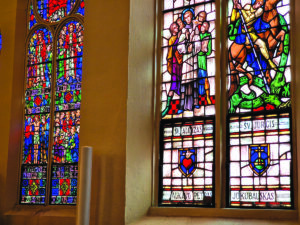
1. Christian was captivated by the grandeur of the surviving Lithuanian buildings and landmarks. Waterbury is the only place in Connecticut that still has a Lithuanian parish. Although a Lithuanian church remains in Hartford, the former Lithuanian neighborhood was destroyed during an “urban renewal.” Therefore, it is essential to preserve Lithuanian buildings and landmarks to attract young people who crave diversity, history, and beautiful architecture. They are weary of the uniformity of the suburbs and seek something unique.
2. Christian notes that making information about Lithuanian organizations and buildings available to the public is crucial. “When I joined the parish, I realized there was no information available on Google Maps about our church and other Lithuanian buildings. Therefore, I took photos, added them to Google Maps, and shared the information. It’s essential for new members to have access to this information, not just the existing members,” he said. Christian thanked me for creating a website that provided historical information about Lithuanian buildings in Waterbury. He mentioned that he wouldn’t have been so involved in Lithuanian activities without the information on the website, including the interview with Linas Balsys that we recorded in 2017.
3. Christian was pleased to be welcomed by the old parishioners at the Waterbury Lithuanian parish without hesitation. He appreciated that they didn’t have the mindset of “no, it can’t be like that; it has always been like that and it will be like that.” He understood the importance of his knowledge and contribution to preserving the parish and Lithuanian identity in the town. He also recognized that his involvement is crucial for the Lithuanian community to attract new members.
We brought back mixed feelings from Waterbury, Connecticut. On one hand, we witnessed a remarkable resurgence of the Lithuanian district, unlike any other in America. New locals of Lithuanian ancestry are rediscovering their heritage, joining the parish and Lithuanian organizations, and revitalizing the area by putting up Lithuanian tricolors, celebrating St. John’s Eve, and planning to open a Lithuanian museum. On the other hand, the diocese’s unexpected decision to close the Lithuanian church may “bury the district again.” This is because it was the last surviving Lithuanian institution in the area, drawing suburban Lithuanians to the district every Sunday. It would be a shame for one of the best-preserved first-wave Lithuanian districts in America to be destroyed.
In the next issue of Draugas News, we will cover the latest developments regarding the Lithuanian community in Waterbury, Connecticut.
“Draugas NEWS”, November 2023 edition.
 DRAUGAS NEWS Lithuanian World Wide News in English
DRAUGAS NEWS Lithuanian World Wide News in English
